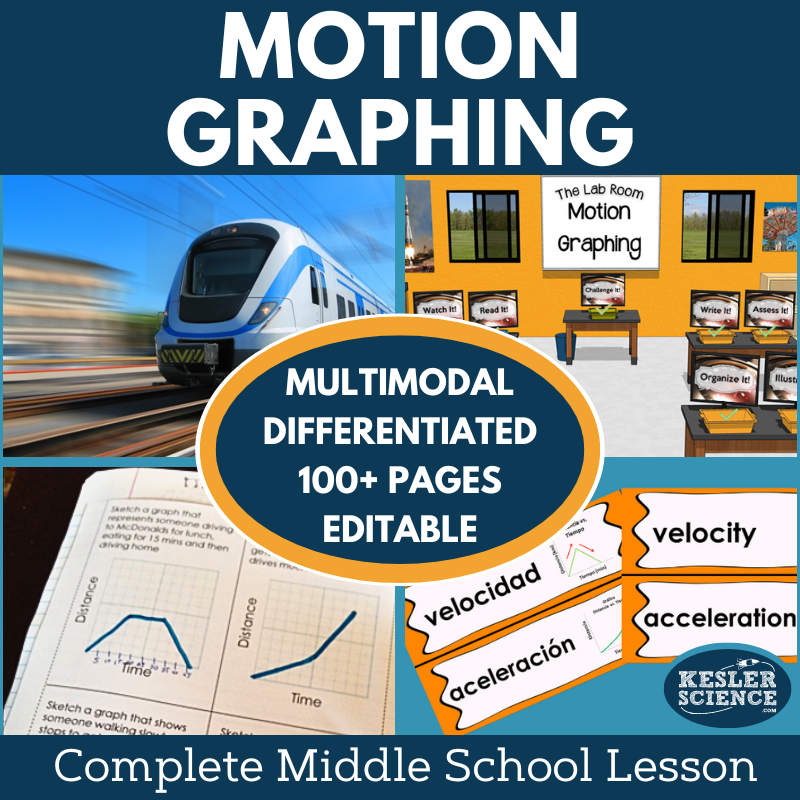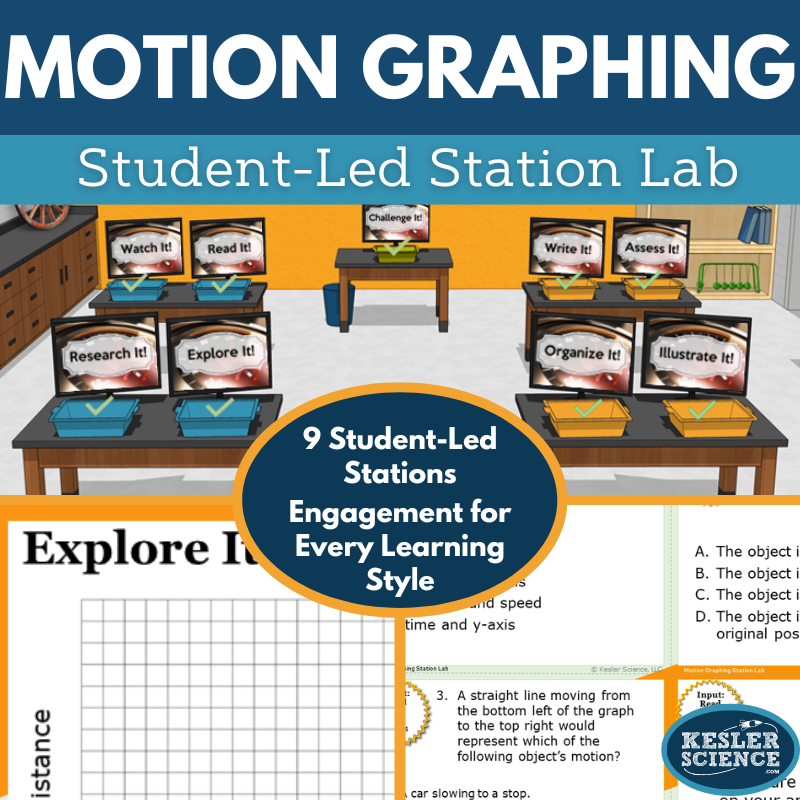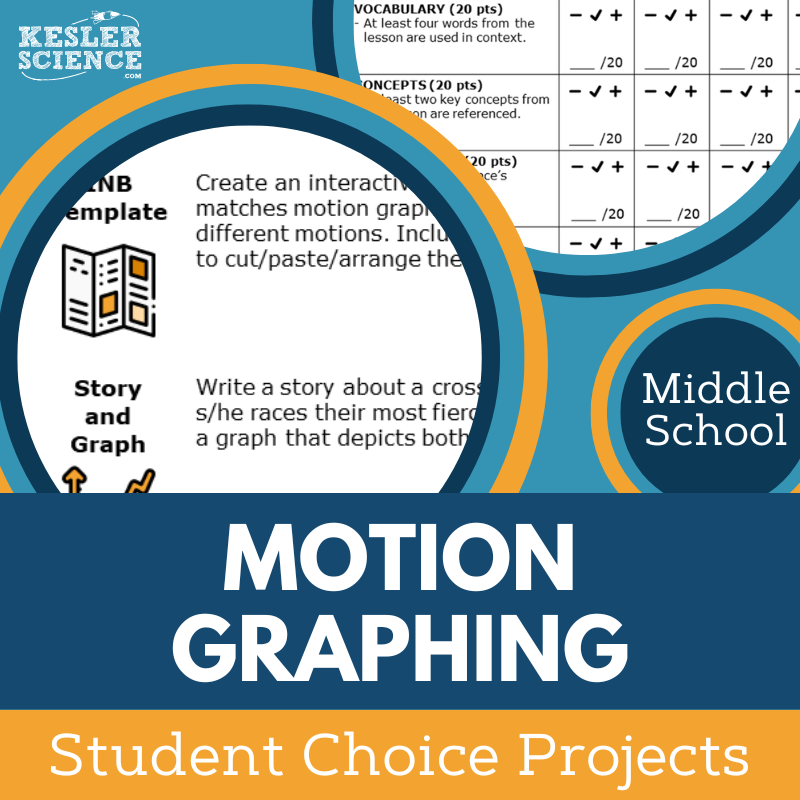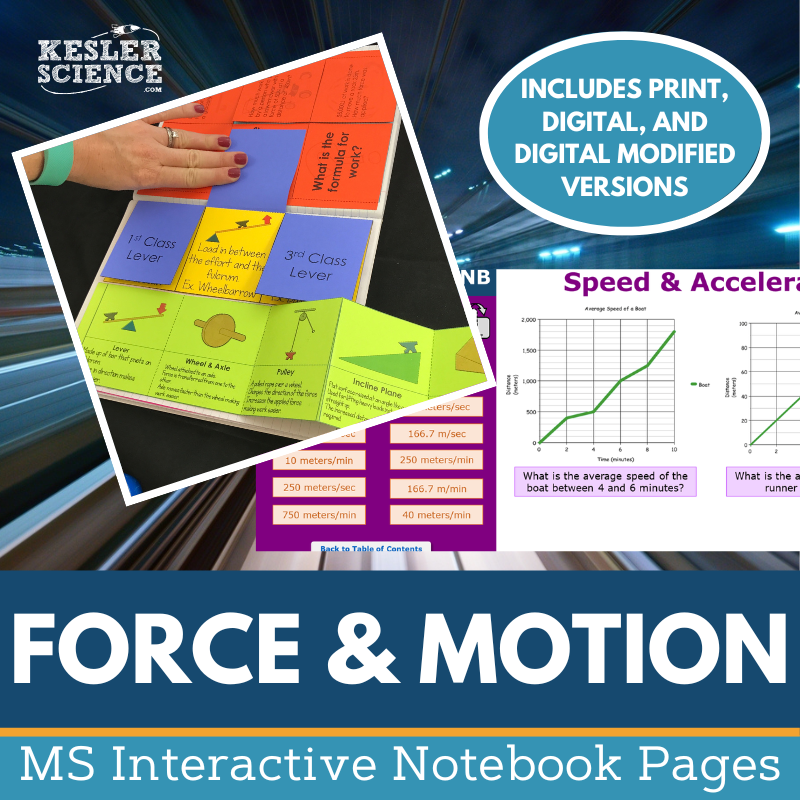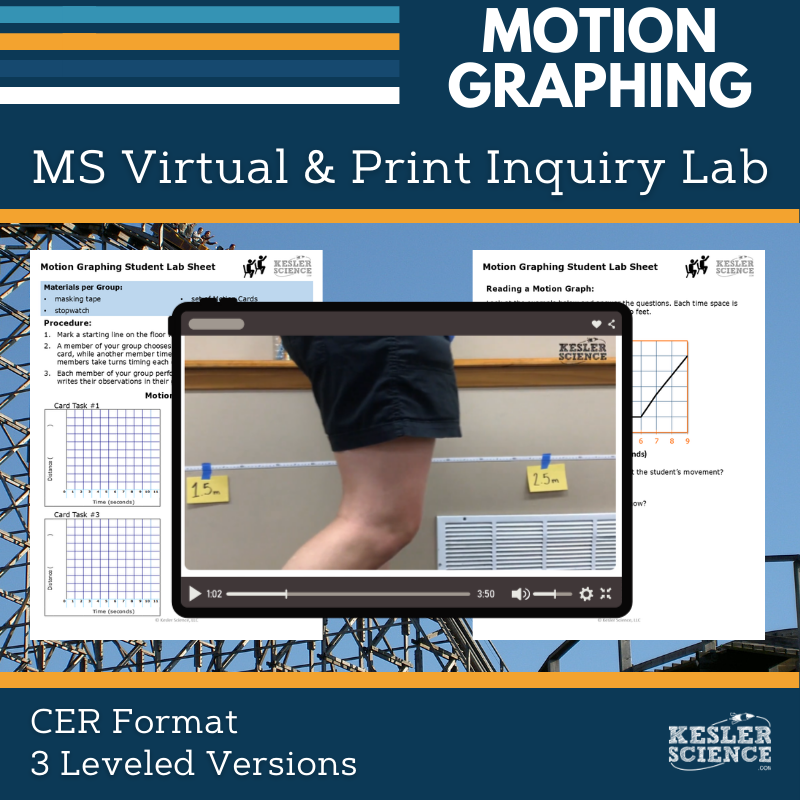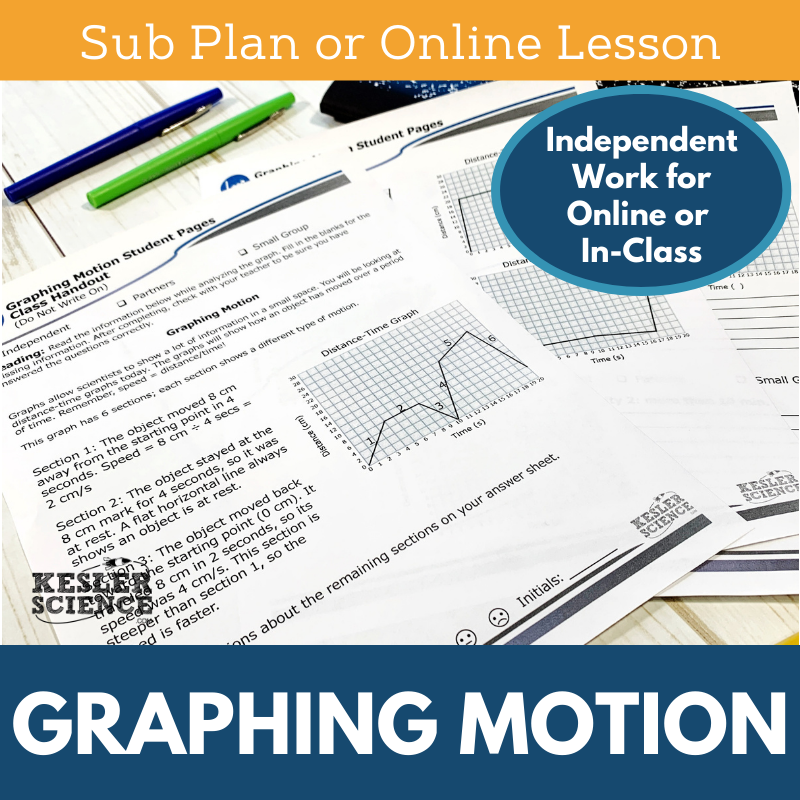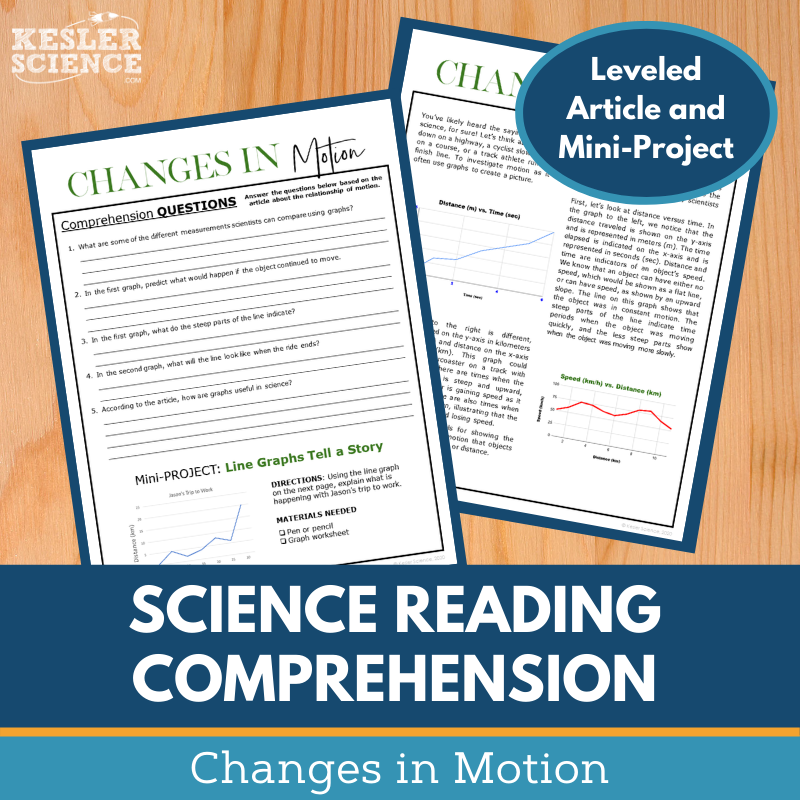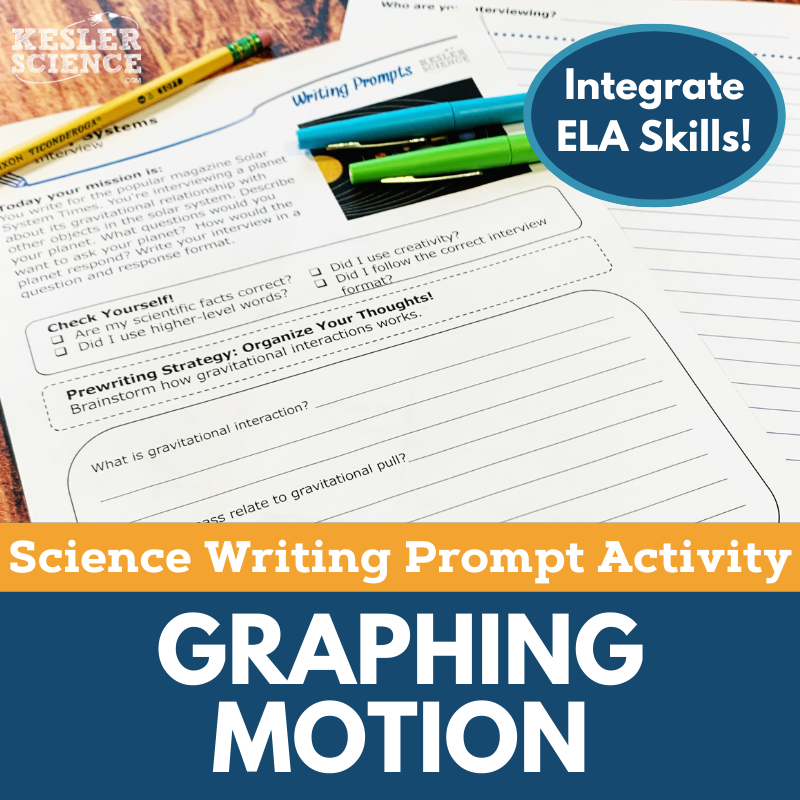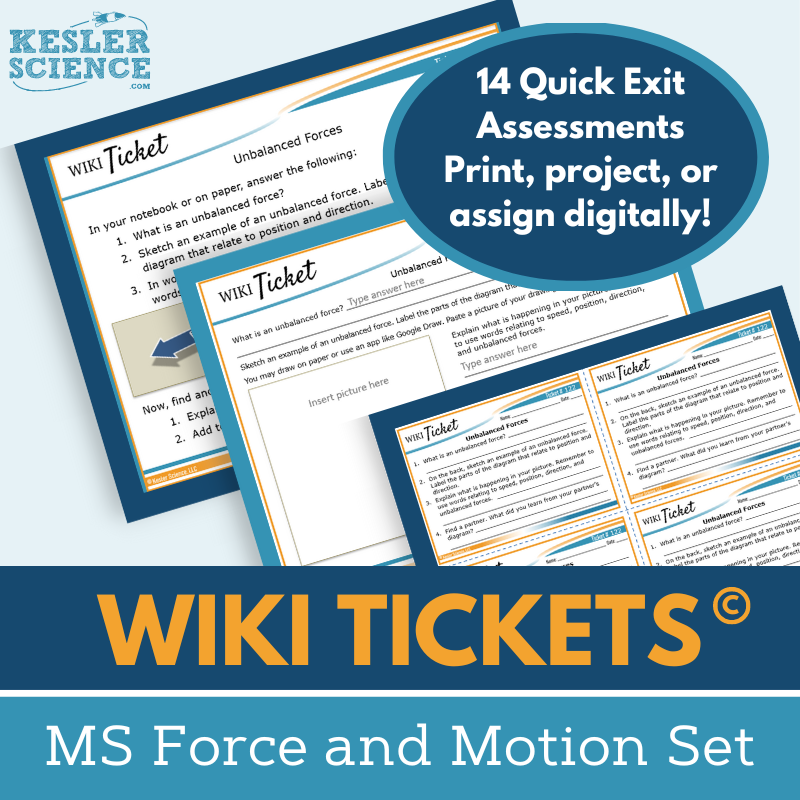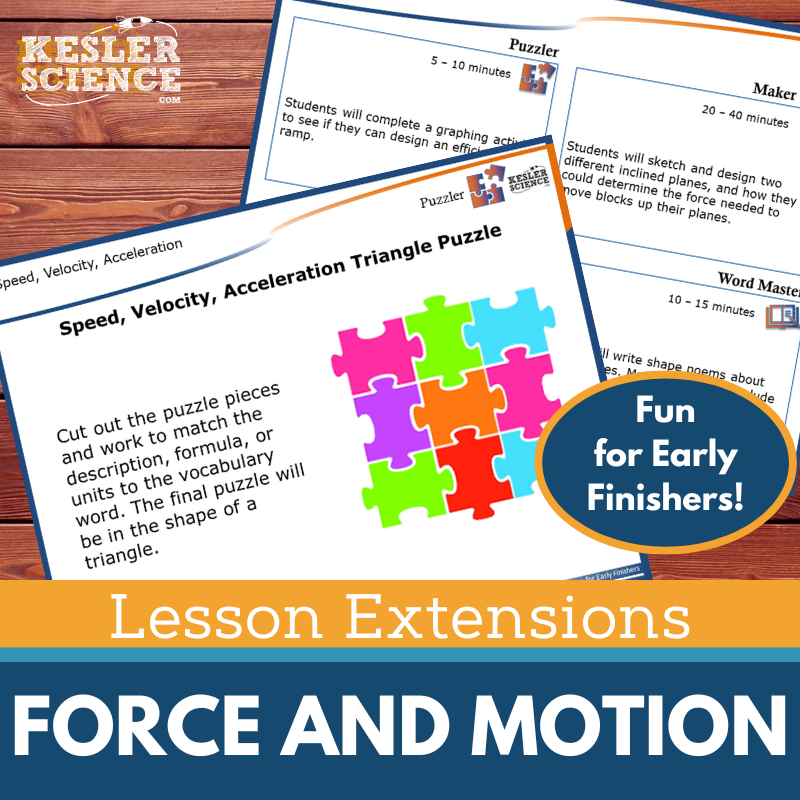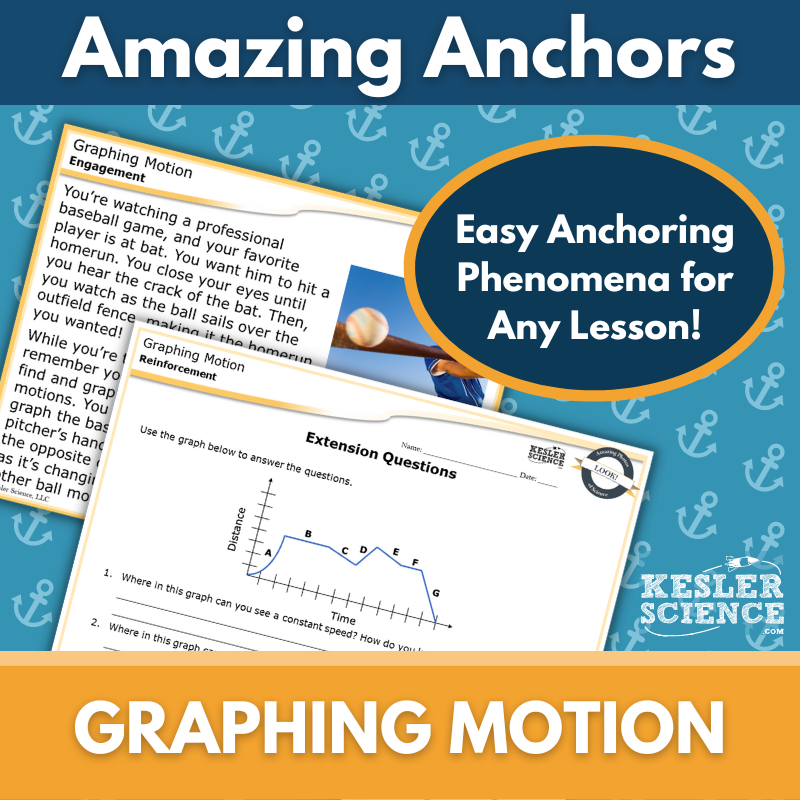Motion Graphing Activities for Middle School Science
The Kesler Science Graphing Motion resources offer a comprehensive, student-centered approach to teaching motion graphing concepts, with differentiated activities that cater to diverse learning styles. The resources below will give students a comprehensive understanding of graphing motion. All of the following materials are also included in the Kesler Science Membership.
The Kesler Science Motion Graphing Complete 5E Lesson provides everything needed to teach a dynamic, multi-day lesson on motion graphing with minimal prep. Through a student-led approach, middle school students explore and graph motion while addressing essential questions like: "How can you measure and graph changes in motion? Can you interpret a motion graph?"
This lesson is built on the 5E Model and offers differentiated materials, multimodal activities, and both printable and digital formats for maximum flexibility. Students will engage through various input and output stations, including hands-on demos, readings, videos, and writing exercises, with a bonus challenge station for early finishers.
The lesson includes editable PowerPoints, interactive notebooks, assessment tools, and Spanish translations, providing comprehensive resources for both in-class and virtual learning environments. With activities tailored to different learning styles, students gain a deep understanding of motion graphing concepts.
The Kesler Science Motion Graphing Complete 5E Lesson provides everything needed to teach a dynamic, multi-day lesson on motion graphing with minimal prep. Through a student-led approach, middle school students explore and graph motion while addressing essential questions like: "How can you measure and graph changes in motion? Can you interpret a motion graph?"
This lesson is built on the 5E Model and offers differentiated materials, multimodal activities, and both printable and digital formats for maximum flexibility. Students will engage through various input and output stations, including hands-on demos, readings, videos, and writing exercises, with a bonus challenge station for early finishers.
The lesson includes editable PowerPoints, interactive notebooks, assessment tools, and Spanish translations, providing comprehensive resources for both in-class and virtual learning environments. With activities tailored to different learning styles, students gain a deep understanding of motion graphing concepts.
The Kesler Science Motion Graphing Station Lab is an engaging, student-driven activity that helps middle school students explore motion and graphing concepts. With minimal prep, this modular setup offers a dynamic, hands-on learning experience where students measure and graph changes in motion across eight differentiated stations.
Each station supports independent or small-group work, allowing students to engage with motion graphing through various input and output activities, including reading passages, videos, hands-on tasks, and digital tools. The lab includes a challenge station for early finishers, ensuring the lesson is both engaging and tailored to various learning needs.
The lab setup includes all necessary signage, literature, and task cards, with the flexibility to work on campus or in virtual environments. Activities cater to different learning styles and can be adapted for various student levels, ensuring that every student can actively participate and demonstrate their understanding.
The Kesler Science Motion Graphing Station Lab is an engaging, student-driven activity that helps middle school students explore motion and graphing concepts. With minimal prep, this modular setup offers a dynamic, hands-on learning experience where students measure and graph changes in motion across eight differentiated stations.
Each station supports independent or small-group work, allowing students to engage with motion graphing through various input and output activities, including reading passages, videos, hands-on tasks, and digital tools. The lab includes a challenge station for early finishers, ensuring the lesson is both engaging and tailored to various learning needs.
The lab setup includes all necessary signage, literature, and task cards, with the flexibility to work on campus or in virtual environments. Activities cater to different learning styles and can be adapted for various student levels, ensuring that every student can actively participate and demonstrate their understanding.
The Kesler Science Motion Graphing Student Choice Projects allow middle school students to select from six project options, with the flexibility to design their own project. The accompanying grading rubric supports assessments by teachers, peers, or students, and is adaptable to various grading needs.
With nine project choices and a "design your own" option, these projects offer multimodal ways for students to demonstrate their understanding. The activities are differentiated for students of varying levels, with modified versions to support learners who need more assistance and more challenging options for advanced students.
Projects utilize common classroom supplies such as paper, markers, and scissors, and many can be completed digitally. Crafting materials may be helpful for students creating physical models.
The Kesler Science Motion Graphing Student Choice Projects allow middle school students to select from six project options, with the flexibility to design their own project. The accompanying grading rubric supports assessments by teachers, peers, or students, and is adaptable to various grading needs.
With nine project choices and a "design your own" option, these projects offer multimodal ways for students to demonstrate their understanding. The activities are differentiated for students of varying levels, with modified versions to support learners who need more assistance and more challenging options for advanced students.
Projects utilize common classroom supplies such as paper, markers, and scissors, and many can be completed digitally. Crafting materials may be helpful for students creating physical models.
The Kesler Science Force and Motion Interactive Notebook offers a dynamic way to engage students in learning key physics concepts. This resource includes both print and digital versions, making it adaptable for any classroom setting, including traditional, 1:1 environments, and distance learning.
The notebook covers essential topics such as speed, velocity, acceleration, Newton’s laws, simple machines, and motion graphing. The digital version includes a PowerPoint file that can be uploaded to platforms like Google Slides, MS Teams, or Canvas. It also features reflection pages, space for note-taking, and a modified version for students with accommodations.
For in-person learning, the paper version provides blank and pre-filled templates with color photos for easy use. Whether online or in the classroom, the Force and Motion Interactive Notebook is a versatile tool that helps students actively engage with and understand the material.
The Kesler Science Force and Motion Interactive Notebook offers a dynamic way to engage students in learning key physics concepts. This resource includes both print and digital versions, making it adaptable for any classroom setting, including traditional, 1:1 environments, and distance learning.
The notebook covers essential topics such as speed, velocity, acceleration, Newton’s laws, simple machines, and motion graphing. The digital version includes a PowerPoint file that can be uploaded to platforms like Google Slides, MS Teams, or Canvas. It also features reflection pages, space for note-taking, and a modified version for students with accommodations.
For in-person learning, the paper version provides blank and pre-filled templates with color photos for easy use. Whether online or in the classroom, the Force and Motion Interactive Notebook is a versatile tool that helps students actively engage with and understand the material.
The Kesler Science Motion Graphing Inquiry Lab aligns with the NGSS and gives students a hands-on opportunity to explore how motion can be represented on a graph. Students will either complete a virtual lab—featuring a teacher-led video and interactive slides—or participate in a print-based experiment using stopwatch timing and motion cards. Both formats guide students through comprehension questions, Claim-Evidence-Reasoning (C.E.R.) writing, and reflection activities.
Each lab includes three differentiated levels—Dependent, Modified, and Independent—to meet diverse learning needs. The Dependent version includes guided instructions with inquiry prompts, the Modified version offers additional supports like sentence stems and multiple-choice questions, and the Independent version challenges students to design and carry out procedures with minimal guidance. In the hands-on version, students use pre-made or self-created motion cards to conduct trials and graph the results.
The digital lab requires no materials and simulates the investigation with a balloon and string setup to measure distance traveled at different inflation levels. All files are editable and compatible with Google Slides or PowerPoint, and include teacher resources such as answer keys, prep directions, and standards. This flexible lab experience is ideal for any classroom setting.
The Kesler Science Motion Graphing Inquiry Lab aligns with the NGSS and gives students a hands-on opportunity to explore how motion can be represented on a graph. Students will either complete a virtual lab—featuring a teacher-led video and interactive slides—or participate in a print-based experiment using stopwatch timing and motion cards. Both formats guide students through comprehension questions, Claim-Evidence-Reasoning (C.E.R.) writing, and reflection activities.
Each lab includes three differentiated levels—Dependent, Modified, and Independent—to meet diverse learning needs. The Dependent version includes guided instructions with inquiry prompts, the Modified version offers additional supports like sentence stems and multiple-choice questions, and the Independent version challenges students to design and carry out procedures with minimal guidance. In the hands-on version, students use pre-made or self-created motion cards to conduct trials and graph the results.
The digital lab requires no materials and simulates the investigation with a balloon and string setup to measure distance traveled at different inflation levels. All files are editable and compatible with Google Slides or PowerPoint, and include teacher resources such as answer keys, prep directions, and standards. This flexible lab experience is ideal for any classroom setting.
The Kesler Science Graphing Motion Sub Plan provides a structured and comprehensive lesson that includes a warm-up, reading passage, independent activity, extension activities, and assessment. Students start with a puzzle, followed by a passage and an analysis of motion graphs. Early finishers can extend their learning by creating their own motion graph or writing a story about one of the graphs.
This sub plan includes extensive instructions for substitutes, making it easy for them to manage the class, and a distance learning version with a Google Form answer sheet. The lesson is designed to be engaging, with no downtime, and includes clear instructions, behavior checkpoints, and editable documents to adapt to your classroom needs.
Everything needed for a smooth lesson is included: substitute directions, answer keys, extension activities, summative assessments, and student PDFs for in-person or online use. This makes the Graphing Motion Sub Plan perfect for in-class or virtual learning environments.
The Kesler Science Graphing Motion Sub Plan provides a structured and comprehensive lesson that includes a warm-up, reading passage, independent activity, extension activities, and assessment. Students start with a puzzle, followed by a passage and an analysis of motion graphs. Early finishers can extend their learning by creating their own motion graph or writing a story about one of the graphs.
This sub plan includes extensive instructions for substitutes, making it easy for them to manage the class, and a distance learning version with a Google Form answer sheet. The lesson is designed to be engaging, with no downtime, and includes clear instructions, behavior checkpoints, and editable documents to adapt to your classroom needs.
Everything needed for a smooth lesson is included: substitute directions, answer keys, extension activities, summative assessments, and student PDFs for in-person or online use. This makes the Graphing Motion Sub Plan perfect for in-class or virtual learning environments.
The Kesler Science Changes in Motion Reading Comprehension activity helps middle school students explore how to measure and graph changes in motion through a nonfiction article. After reading, students answer comprehension questions and create a narrative based on changes in a line graph, deepening both their science and reading skills. This engaging activity promotes science literacy and reinforces key concepts related to motion.
Designed for grades 6-8, this leveled passage features Lexile levels of 1100-1300 and includes a mini-project to apply the concepts learned. Students can benefit from differentiated reading options, with one article at a higher level and another with more accessible text. Colorful graphics, a Cornell notes template, and 5-7 comprehension questions support students' understanding and engagement.
Perfect for both in-class and remote learning environments, this resource is compatible with Google Classroom, MS Teams, Schoology, and Canvas. Teachers can use it for a variety of purposes, such as science sub plans, extra credit, or as part of ongoing lessons to build science reading comprehension. It’s a flexible, low-prep tool to foster discussion, analysis, and science literacy in middle school classrooms.
The Kesler Science Changes in Motion Reading Comprehension activity helps middle school students explore how to measure and graph changes in motion through a nonfiction article. After reading, students answer comprehension questions and create a narrative based on changes in a line graph, deepening both their science and reading skills. This engaging activity promotes science literacy and reinforces key concepts related to motion.
Designed for grades 6-8, this leveled passage features Lexile levels of 1100-1300 and includes a mini-project to apply the concepts learned. Students can benefit from differentiated reading options, with one article at a higher level and another with more accessible text. Colorful graphics, a Cornell notes template, and 5-7 comprehension questions support students' understanding and engagement.
Perfect for both in-class and remote learning environments, this resource is compatible with Google Classroom, MS Teams, Schoology, and Canvas. Teachers can use it for a variety of purposes, such as science sub plans, extra credit, or as part of ongoing lessons to build science reading comprehension. It’s a flexible, low-prep tool to foster discussion, analysis, and science literacy in middle school classrooms.
The Kesler Science Graphing Motion Writing Prompt Activity offers an engaging way for middle school students to deepen their understanding of physical science. Using a creative narrative, students test their knowledge of graphing motion while practicing science reasoning and writing skills. This activity is designed to be adaptable for various learning environments, whether in the classroom or virtually.
Each resource includes comprehensive teacher directions, a detailed answer guide, and both full and half-sheet rubrics for easy grading. The activity can be projected for whole-class engagement or printed for individual student use, making it a versatile tool for different classroom setups. It also includes a digital version that can be assigned through PowerPoint or Google Slides, ideal for remote learners.
This activity is aligned with TEKS and NGSS standards, offering a variety of uses such as pre-test assessments, student choice projects, and extra credit. It’s perfect for elaborating on concepts with early finishers, make-up work, or differentiation exercises, providing teachers with a flexible, low-prep resource to enhance student learning and engagement.
The Kesler Science Graphing Motion Writing Prompt Activity offers an engaging way for middle school students to deepen their understanding of physical science. Using a creative narrative, students test their knowledge of graphing motion while practicing science reasoning and writing skills. This activity is designed to be adaptable for various learning environments, whether in the classroom or virtually.
Each resource includes comprehensive teacher directions, a detailed answer guide, and both full and half-sheet rubrics for easy grading. The activity can be projected for whole-class engagement or printed for individual student use, making it a versatile tool for different classroom setups. It also includes a digital version that can be assigned through PowerPoint or Google Slides, ideal for remote learners.
This activity is aligned with TEKS and NGSS standards, offering a variety of uses such as pre-test assessments, student choice projects, and extra credit. It’s perfect for elaborating on concepts with early finishers, make-up work, or differentiation exercises, providing teachers with a flexible, low-prep resource to enhance student learning and engagement.
The Kesler Science formative Force and Motion WIKI ticket assessments offer flexible, engaging options for checking student understanding. This set includes 14 assessments, each with five formats: a full-screen display version for projection, three handout sizes, and an interactive digital version (PPT or Google Slides). These assessments are aligned with NGSS and TEKS standards, covering topics like speed, unbalanced forces, and Newton’s laws.
WIKI Tickets provide a fun, interactive way to gauge students' progress, perfect for use as exit tickets, bellringers, or formative assessments during lessons. The resource works well in both traditional and virtual learning environments, allowing for easy adaptation to any classroom setting.
Each topic includes multiple formats, making it easy to implement in-person or online. Whether projected in class or completed digitally, these colorful assessments allow for continuous student engagement and real-time understanding checks, helping you monitor student progress throughout the unit.
The Kesler Science formative Force and Motion WIKI ticket assessments offer flexible, engaging options for checking student understanding. This set includes 14 assessments, each with five formats: a full-screen display version for projection, three handout sizes, and an interactive digital version (PPT or Google Slides). These assessments are aligned with NGSS and TEKS standards, covering topics like speed, unbalanced forces, and Newton’s laws.
WIKI Tickets provide a fun, interactive way to gauge students' progress, perfect for use as exit tickets, bellringers, or formative assessments during lessons. The resource works well in both traditional and virtual learning environments, allowing for easy adaptation to any classroom setting.
Each topic includes multiple formats, making it easy to implement in-person or online. Whether projected in class or completed digitally, these colorful assessments allow for continuous student engagement and real-time understanding checks, helping you monitor student progress throughout the unit.
The Kesler Science Force and Motion Lesson Extensions are designed to engage fast finishers with critical thinking and creativity. These activities offer a mix of rigor and fun, providing an ideal way to wrap up lessons or keep students occupied during testing. The activities help deepen understanding of force and motion while aligning with NGSS and TEKS standards.
Each extension includes four different types of activities: Puzzler, Maker Space, Tech Connection, and Word Master. These activities are student-driven, allowing for personalized learning experiences. Whether it’s solving puzzles, building models, exploring digital media, or expressing ideas through creative writing, each activity promotes critical thinking and hands-on engagement.
These extensions come with teacher directions, answer keys, and printable versions. The materials are flexible, allowing for use in both digital and in-person settings. Perfect for advanced learners or as supplementary activities, they provide a structured yet engaging way to dive deeper into topics like gravity, Newton’s laws, and speed.
The Kesler Science Force and Motion Lesson Extensions are designed to engage fast finishers with critical thinking and creativity. These activities offer a mix of rigor and fun, providing an ideal way to wrap up lessons or keep students occupied during testing. The activities help deepen understanding of force and motion while aligning with NGSS and TEKS standards.
Each extension includes four different types of activities: Puzzler, Maker Space, Tech Connection, and Word Master. These activities are student-driven, allowing for personalized learning experiences. Whether it’s solving puzzles, building models, exploring digital media, or expressing ideas through creative writing, each activity promotes critical thinking and hands-on engagement.
These extensions come with teacher directions, answer keys, and printable versions. The materials are flexible, allowing for use in both digital and in-person settings. Perfect for advanced learners or as supplementary activities, they provide a structured yet engaging way to dive deeper into topics like gravity, Newton’s laws, and speed.
The Amazing Anchors Phenomenon Lesson introduces and reinforces graphing motion through a real-world connection to baseball. Students begin with an introductory reading about the motion of a ball during a game, using comprehension and extension questions to spark curiosity and prepare for deeper learning. A follow-up explanatory reading breaks down the science behind interpreting motion graphs in a clear, student-friendly way, with additional questions to reinforce understanding.
The resource is TEKS-aligned and comes with teacher directions, answer keys, and editable materials in both print and digital formats. Full-page projection slides, half-sheet and full-sheet handouts, and PowerPoint files are included to support flexible classroom use. A modified version offers sentence starters and language support to assist diverse learners with comprehension tasks.
Designed to bookend any core lesson, Amazing Anchors Phenomenon Pages work well in the Engagement and Elaborate phases of the 5E Model. Whether used in-person or virtually, this no-prep activity encourages students to connect scientific concepts like graphing motion to meaningful, real-world phenomena.
The Amazing Anchors Phenomenon Lesson introduces and reinforces graphing motion through a real-world connection to baseball. Students begin with an introductory reading about the motion of a ball during a game, using comprehension and extension questions to spark curiosity and prepare for deeper learning. A follow-up explanatory reading breaks down the science behind interpreting motion graphs in a clear, student-friendly way, with additional questions to reinforce understanding.
The resource is TEKS-aligned and comes with teacher directions, answer keys, and editable materials in both print and digital formats. Full-page projection slides, half-sheet and full-sheet handouts, and PowerPoint files are included to support flexible classroom use. A modified version offers sentence starters and language support to assist diverse learners with comprehension tasks.
Designed to bookend any core lesson, Amazing Anchors Phenomenon Pages work well in the Engagement and Elaborate phases of the 5E Model. Whether used in-person or virtually, this no-prep activity encourages students to connect scientific concepts like graphing motion to meaningful, real-world phenomena.
Year-Round Resources
These year-round activities will increase your students' understanding of many middle school science topics. All of these activities are also included in the Kesler Science Membership.
Visual Data & Graphing
You're not alone if your students struggle with understanding graphs, charts, and tables. It's a skill that takes an enormous amount of practice. This resource will help students build a strong foundation in analyzing data and creating their own data visualizations.
Bell Ringers and Warm-Ups
These middle school science bell ringers are an excellent way to engage your students as soon as they walk into your classroom. This comprehensive FULL YEAR resource includes everything you need to start off each science class with an interesting warm-up activity.
Review Board Games
Each game board has been carefully designed to keep students engaged. There are 10 different action spaces on each board and dozens of question cards. All of the actions are related to science concepts and keep the students motivated throughout the game.
Each game is ready to play. Simply print out the board and the cards and let the students enjoy reviewing nine different units.
Essential Questions
Below are the essential questions associated with the lessons and activities included in this unit. This topic is only one of more than 100 middle school science topics included in the Kesler Science Membership.
-
Can you measure and graph changes in motion?
-
Can you interpret an object’s motion from a graph?
-
Can you describe the characteristics of a motion graph?
Kesler Science Membership
Imagine never having to search for another middle school science lesson again. The membership gives you access to ALL of the Kesler Science products in one place (Yes, including everything above).
Say goodbye to long hours of lesson prep.

